Financial Analysis and Performance Report for Bellovida Ltd
VerifiedAdded on 2020/06/06
|16
|4462
|374
Report
AI Summary
This report provides a comprehensive financial analysis of Bellovida Ltd, evaluating its performance using ratio analysis, including profitability, liquidity, efficiency, and gearing ratios. The analysis extends to non-financial aspects impacting business performance, such as customer retention and employee turnover. Furthermore, the report delves into break-even point analysis, calculating the break-even point in units and value, along with margin of safety. Investment appraisal techniques, including payback period, ARR, and NPV are applied to evaluate investment decisions. The report also examines working capital management, pricing strategies, and budgeting methods, providing a holistic view of the company's financial health and strategic planning.
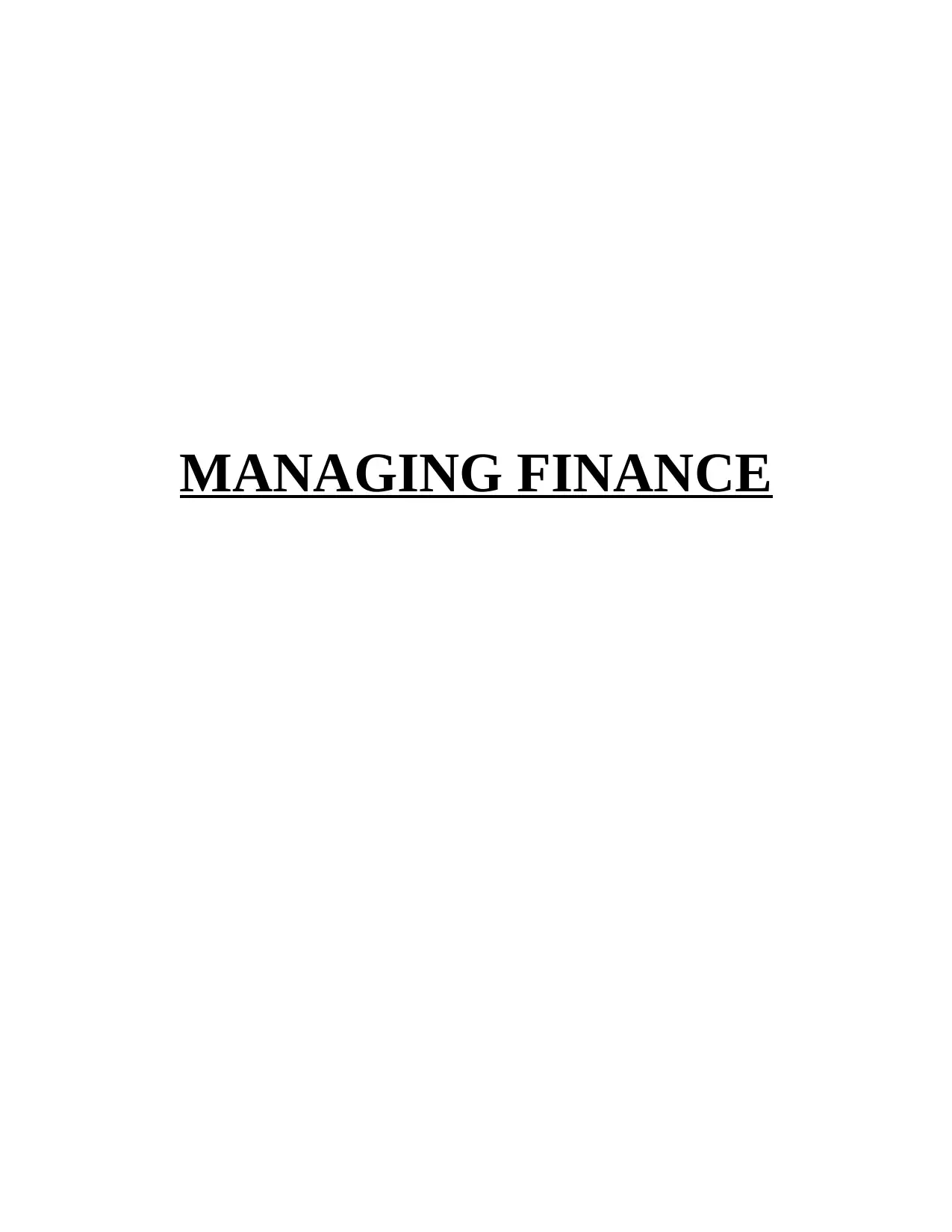
MANAGING FINANCE
Paraphrase This Document
Need a fresh take? Get an instant paraphrase of this document with our AI Paraphraser
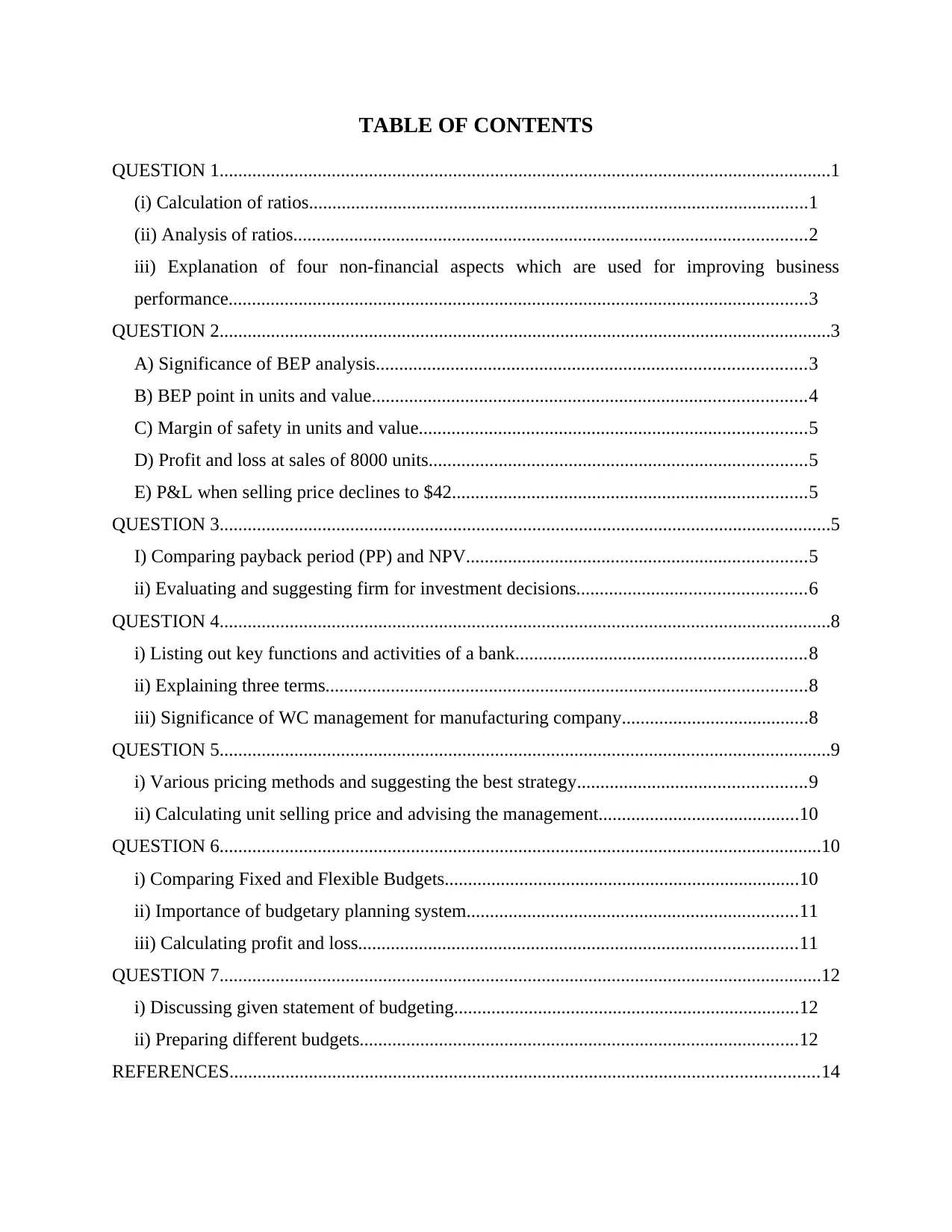
TABLE OF CONTENTS
QUESTION 1...................................................................................................................................1
(i) Calculation of ratios...........................................................................................................1
(ii) Analysis of ratios..............................................................................................................2
iii) Explanation of four non-financial aspects which are used for improving business
performance............................................................................................................................3
QUESTION 2...................................................................................................................................3
A) Significance of BEP analysis............................................................................................3
B) BEP point in units and value.............................................................................................4
C) Margin of safety in units and value...................................................................................5
D) Profit and loss at sales of 8000 units.................................................................................5
E) P&L when selling price declines to $42............................................................................5
QUESTION 3...................................................................................................................................5
I) Comparing payback period (PP) and NPV.........................................................................5
ii) Evaluating and suggesting firm for investment decisions.................................................6
QUESTION 4...................................................................................................................................8
i) Listing out key functions and activities of a bank..............................................................8
ii) Explaining three terms.......................................................................................................8
iii) Significance of WC management for manufacturing company........................................8
QUESTION 5...................................................................................................................................9
i) Various pricing methods and suggesting the best strategy.................................................9
ii) Calculating unit selling price and advising the management...........................................10
QUESTION 6.................................................................................................................................10
i) Comparing Fixed and Flexible Budgets............................................................................10
ii) Importance of budgetary planning system.......................................................................11
iii) Calculating profit and loss..............................................................................................11
QUESTION 7.................................................................................................................................12
i) Discussing given statement of budgeting..........................................................................12
ii) Preparing different budgets..............................................................................................12
REFERENCES..............................................................................................................................14
QUESTION 1...................................................................................................................................1
(i) Calculation of ratios...........................................................................................................1
(ii) Analysis of ratios..............................................................................................................2
iii) Explanation of four non-financial aspects which are used for improving business
performance............................................................................................................................3
QUESTION 2...................................................................................................................................3
A) Significance of BEP analysis............................................................................................3
B) BEP point in units and value.............................................................................................4
C) Margin of safety in units and value...................................................................................5
D) Profit and loss at sales of 8000 units.................................................................................5
E) P&L when selling price declines to $42............................................................................5
QUESTION 3...................................................................................................................................5
I) Comparing payback period (PP) and NPV.........................................................................5
ii) Evaluating and suggesting firm for investment decisions.................................................6
QUESTION 4...................................................................................................................................8
i) Listing out key functions and activities of a bank..............................................................8
ii) Explaining three terms.......................................................................................................8
iii) Significance of WC management for manufacturing company........................................8
QUESTION 5...................................................................................................................................9
i) Various pricing methods and suggesting the best strategy.................................................9
ii) Calculating unit selling price and advising the management...........................................10
QUESTION 6.................................................................................................................................10
i) Comparing Fixed and Flexible Budgets............................................................................10
ii) Importance of budgetary planning system.......................................................................11
iii) Calculating profit and loss..............................................................................................11
QUESTION 7.................................................................................................................................12
i) Discussing given statement of budgeting..........................................................................12
ii) Preparing different budgets..............................................................................................12
REFERENCES..............................................................................................................................14

⊘ This is a preview!⊘
Do you want full access?
Subscribe today to unlock all pages.

Trusted by 1+ million students worldwide
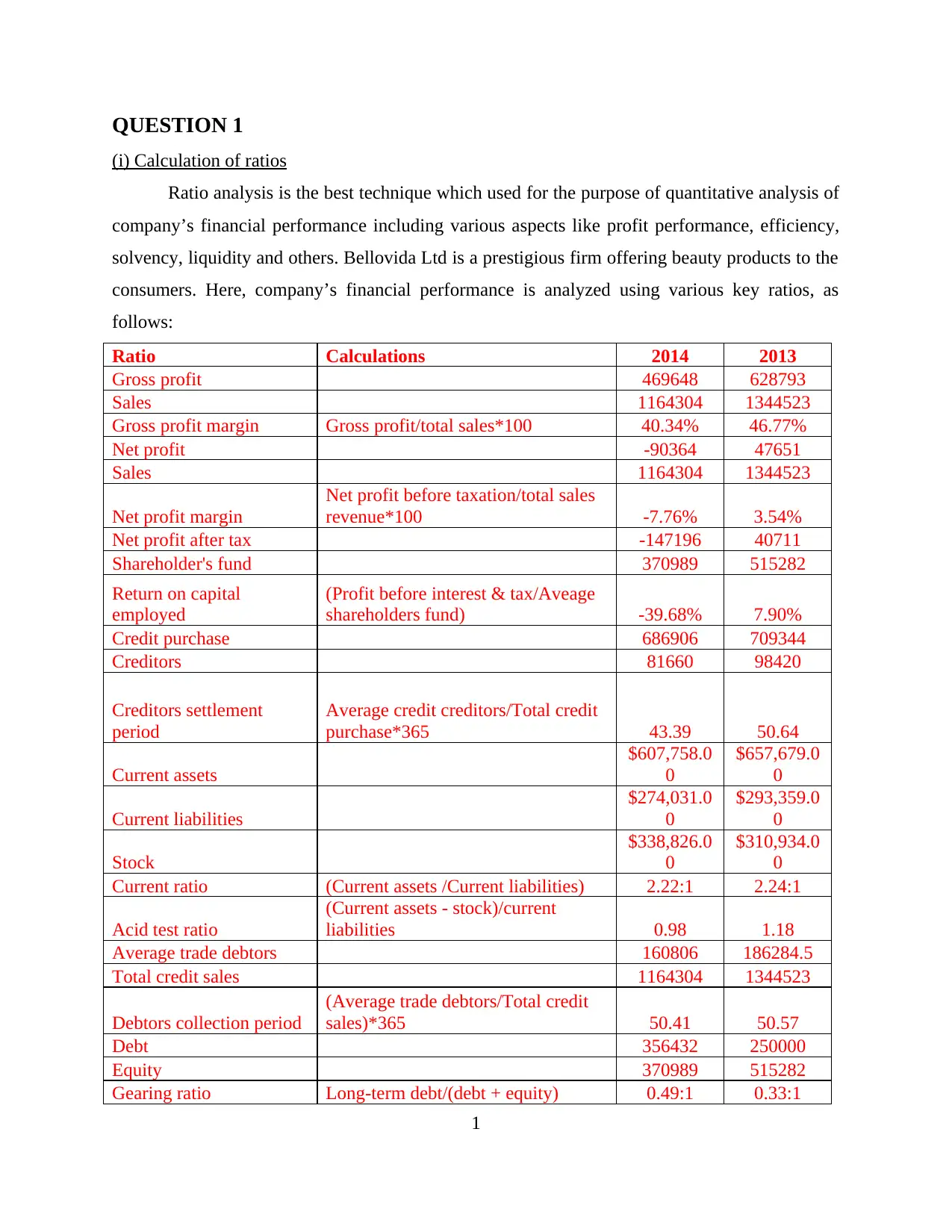
QUESTION 1
(i) Calculation of ratios
Ratio analysis is the best technique which used for the purpose of quantitative analysis of
company’s financial performance including various aspects like profit performance, efficiency,
solvency, liquidity and others. Bellovida Ltd is a prestigious firm offering beauty products to the
consumers. Here, company’s financial performance is analyzed using various key ratios, as
follows:
Ratio Calculations 2014 2013
Gross profit 469648 628793
Sales 1164304 1344523
Gross profit margin Gross profit/total sales*100 40.34% 46.77%
Net profit -90364 47651
Sales 1164304 1344523
Net profit margin
Net profit before taxation/total sales
revenue*100 -7.76% 3.54%
Net profit after tax -147196 40711
Shareholder's fund 370989 515282
Return on capital
employed
(Profit before interest & tax/Aveage
shareholders fund) -39.68% 7.90%
Credit purchase 686906 709344
Creditors 81660 98420
Creditors settlement
period
Average credit creditors/Total credit
purchase*365 43.39 50.64
Current assets
$607,758.0
0
$657,679.0
0
Current liabilities
$274,031.0
0
$293,359.0
0
Stock
$338,826.0
0
$310,934.0
0
Current ratio (Current assets /Current liabilities) 2.22:1 2.24:1
Acid test ratio
(Current assets - stock)/current
liabilities 0.98 1.18
Average trade debtors 160806 186284.5
Total credit sales 1164304 1344523
Debtors collection period
(Average trade debtors/Total credit
sales)*365 50.41 50.57
Debt 356432 250000
Equity 370989 515282
Gearing ratio Long-term debt/(debt + equity) 0.49:1 0.33:1
1
(i) Calculation of ratios
Ratio analysis is the best technique which used for the purpose of quantitative analysis of
company’s financial performance including various aspects like profit performance, efficiency,
solvency, liquidity and others. Bellovida Ltd is a prestigious firm offering beauty products to the
consumers. Here, company’s financial performance is analyzed using various key ratios, as
follows:
Ratio Calculations 2014 2013
Gross profit 469648 628793
Sales 1164304 1344523
Gross profit margin Gross profit/total sales*100 40.34% 46.77%
Net profit -90364 47651
Sales 1164304 1344523
Net profit margin
Net profit before taxation/total sales
revenue*100 -7.76% 3.54%
Net profit after tax -147196 40711
Shareholder's fund 370989 515282
Return on capital
employed
(Profit before interest & tax/Aveage
shareholders fund) -39.68% 7.90%
Credit purchase 686906 709344
Creditors 81660 98420
Creditors settlement
period
Average credit creditors/Total credit
purchase*365 43.39 50.64
Current assets
$607,758.0
0
$657,679.0
0
Current liabilities
$274,031.0
0
$293,359.0
0
Stock
$338,826.0
0
$310,934.0
0
Current ratio (Current assets /Current liabilities) 2.22:1 2.24:1
Acid test ratio
(Current assets - stock)/current
liabilities 0.98 1.18
Average trade debtors 160806 186284.5
Total credit sales 1164304 1344523
Debtors collection period
(Average trade debtors/Total credit
sales)*365 50.41 50.57
Debt 356432 250000
Equity 370989 515282
Gearing ratio Long-term debt/(debt + equity) 0.49:1 0.33:1
1
Paraphrase This Document
Need a fresh take? Get an instant paraphrase of this document with our AI Paraphraser
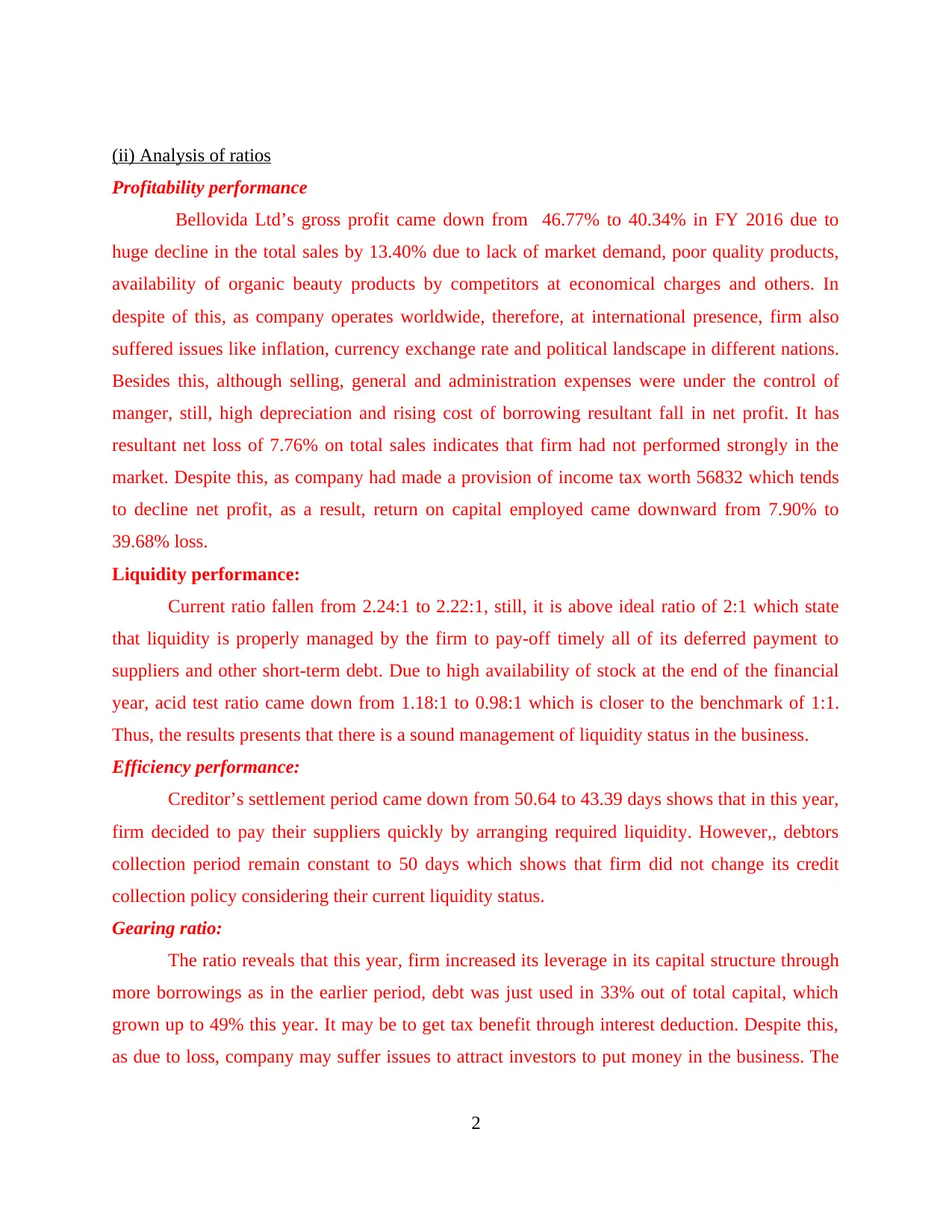
(ii) Analysis of ratios
Profitability performance
Bellovida Ltd’s gross profit came down from 46.77% to 40.34% in FY 2016 due to
huge decline in the total sales by 13.40% due to lack of market demand, poor quality products,
availability of organic beauty products by competitors at economical charges and others. In
despite of this, as company operates worldwide, therefore, at international presence, firm also
suffered issues like inflation, currency exchange rate and political landscape in different nations.
Besides this, although selling, general and administration expenses were under the control of
manger, still, high depreciation and rising cost of borrowing resultant fall in net profit. It has
resultant net loss of 7.76% on total sales indicates that firm had not performed strongly in the
market. Despite this, as company had made a provision of income tax worth 56832 which tends
to decline net profit, as a result, return on capital employed came downward from 7.90% to
39.68% loss.
Liquidity performance:
Current ratio fallen from 2.24:1 to 2.22:1, still, it is above ideal ratio of 2:1 which state
that liquidity is properly managed by the firm to pay-off timely all of its deferred payment to
suppliers and other short-term debt. Due to high availability of stock at the end of the financial
year, acid test ratio came down from 1.18:1 to 0.98:1 which is closer to the benchmark of 1:1.
Thus, the results presents that there is a sound management of liquidity status in the business.
Efficiency performance:
Creditor’s settlement period came down from 50.64 to 43.39 days shows that in this year,
firm decided to pay their suppliers quickly by arranging required liquidity. However,, debtors
collection period remain constant to 50 days which shows that firm did not change its credit
collection policy considering their current liquidity status.
Gearing ratio:
The ratio reveals that this year, firm increased its leverage in its capital structure through
more borrowings as in the earlier period, debt was just used in 33% out of total capital, which
grown up to 49% this year. It may be to get tax benefit through interest deduction. Despite this,
as due to loss, company may suffer issues to attract investors to put money in the business. The
2
Profitability performance
Bellovida Ltd’s gross profit came down from 46.77% to 40.34% in FY 2016 due to
huge decline in the total sales by 13.40% due to lack of market demand, poor quality products,
availability of organic beauty products by competitors at economical charges and others. In
despite of this, as company operates worldwide, therefore, at international presence, firm also
suffered issues like inflation, currency exchange rate and political landscape in different nations.
Besides this, although selling, general and administration expenses were under the control of
manger, still, high depreciation and rising cost of borrowing resultant fall in net profit. It has
resultant net loss of 7.76% on total sales indicates that firm had not performed strongly in the
market. Despite this, as company had made a provision of income tax worth 56832 which tends
to decline net profit, as a result, return on capital employed came downward from 7.90% to
39.68% loss.
Liquidity performance:
Current ratio fallen from 2.24:1 to 2.22:1, still, it is above ideal ratio of 2:1 which state
that liquidity is properly managed by the firm to pay-off timely all of its deferred payment to
suppliers and other short-term debt. Due to high availability of stock at the end of the financial
year, acid test ratio came down from 1.18:1 to 0.98:1 which is closer to the benchmark of 1:1.
Thus, the results presents that there is a sound management of liquidity status in the business.
Efficiency performance:
Creditor’s settlement period came down from 50.64 to 43.39 days shows that in this year,
firm decided to pay their suppliers quickly by arranging required liquidity. However,, debtors
collection period remain constant to 50 days which shows that firm did not change its credit
collection policy considering their current liquidity status.
Gearing ratio:
The ratio reveals that this year, firm increased its leverage in its capital structure through
more borrowings as in the earlier period, debt was just used in 33% out of total capital, which
grown up to 49% this year. It may be to get tax benefit through interest deduction. Despite this,
as due to loss, company may suffer issues to attract investors to put money in the business. The
2
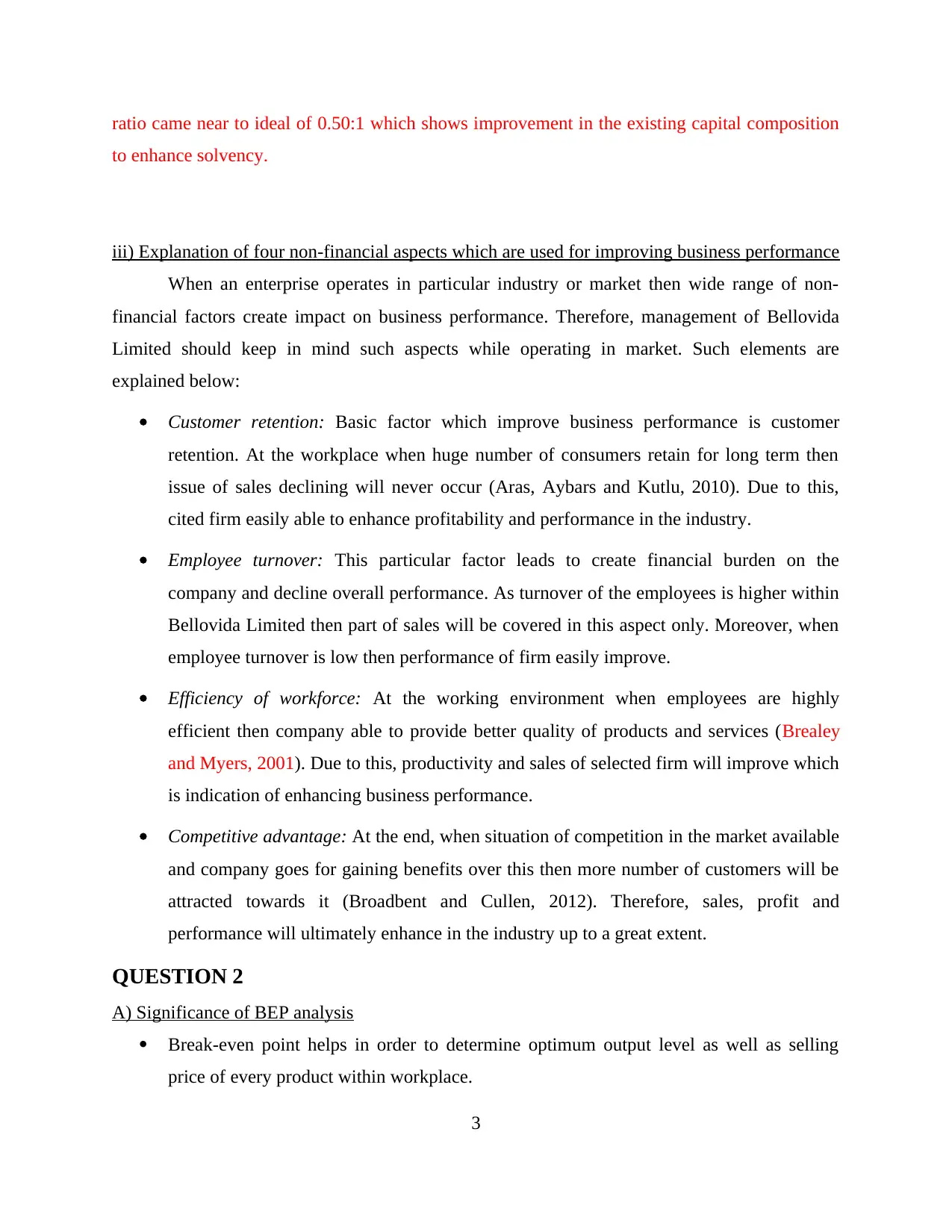
ratio came near to ideal of 0.50:1 which shows improvement in the existing capital composition
to enhance solvency.
iii) Explanation of four non-financial aspects which are used for improving business performance
When an enterprise operates in particular industry or market then wide range of non-
financial factors create impact on business performance. Therefore, management of Bellovida
Limited should keep in mind such aspects while operating in market. Such elements are
explained below:
Customer retention: Basic factor which improve business performance is customer
retention. At the workplace when huge number of consumers retain for long term then
issue of sales declining will never occur (Aras, Aybars and Kutlu, 2010). Due to this,
cited firm easily able to enhance profitability and performance in the industry.
Employee turnover: This particular factor leads to create financial burden on the
company and decline overall performance. As turnover of the employees is higher within
Bellovida Limited then part of sales will be covered in this aspect only. Moreover, when
employee turnover is low then performance of firm easily improve.
Efficiency of workforce: At the working environment when employees are highly
efficient then company able to provide better quality of products and services (Brealey
and Myers, 2001). Due to this, productivity and sales of selected firm will improve which
is indication of enhancing business performance.
Competitive advantage: At the end, when situation of competition in the market available
and company goes for gaining benefits over this then more number of customers will be
attracted towards it (Broadbent and Cullen, 2012). Therefore, sales, profit and
performance will ultimately enhance in the industry up to a great extent.
QUESTION 2
A) Significance of BEP analysis
Break-even point helps in order to determine optimum output level as well as selling
price of every product within workplace.
3
to enhance solvency.
iii) Explanation of four non-financial aspects which are used for improving business performance
When an enterprise operates in particular industry or market then wide range of non-
financial factors create impact on business performance. Therefore, management of Bellovida
Limited should keep in mind such aspects while operating in market. Such elements are
explained below:
Customer retention: Basic factor which improve business performance is customer
retention. At the workplace when huge number of consumers retain for long term then
issue of sales declining will never occur (Aras, Aybars and Kutlu, 2010). Due to this,
cited firm easily able to enhance profitability and performance in the industry.
Employee turnover: This particular factor leads to create financial burden on the
company and decline overall performance. As turnover of the employees is higher within
Bellovida Limited then part of sales will be covered in this aspect only. Moreover, when
employee turnover is low then performance of firm easily improve.
Efficiency of workforce: At the working environment when employees are highly
efficient then company able to provide better quality of products and services (Brealey
and Myers, 2001). Due to this, productivity and sales of selected firm will improve which
is indication of enhancing business performance.
Competitive advantage: At the end, when situation of competition in the market available
and company goes for gaining benefits over this then more number of customers will be
attracted towards it (Broadbent and Cullen, 2012). Therefore, sales, profit and
performance will ultimately enhance in the industry up to a great extent.
QUESTION 2
A) Significance of BEP analysis
Break-even point helps in order to determine optimum output level as well as selling
price of every product within workplace.
3
⊘ This is a preview!⊘
Do you want full access?
Subscribe today to unlock all pages.

Trusted by 1+ million students worldwide
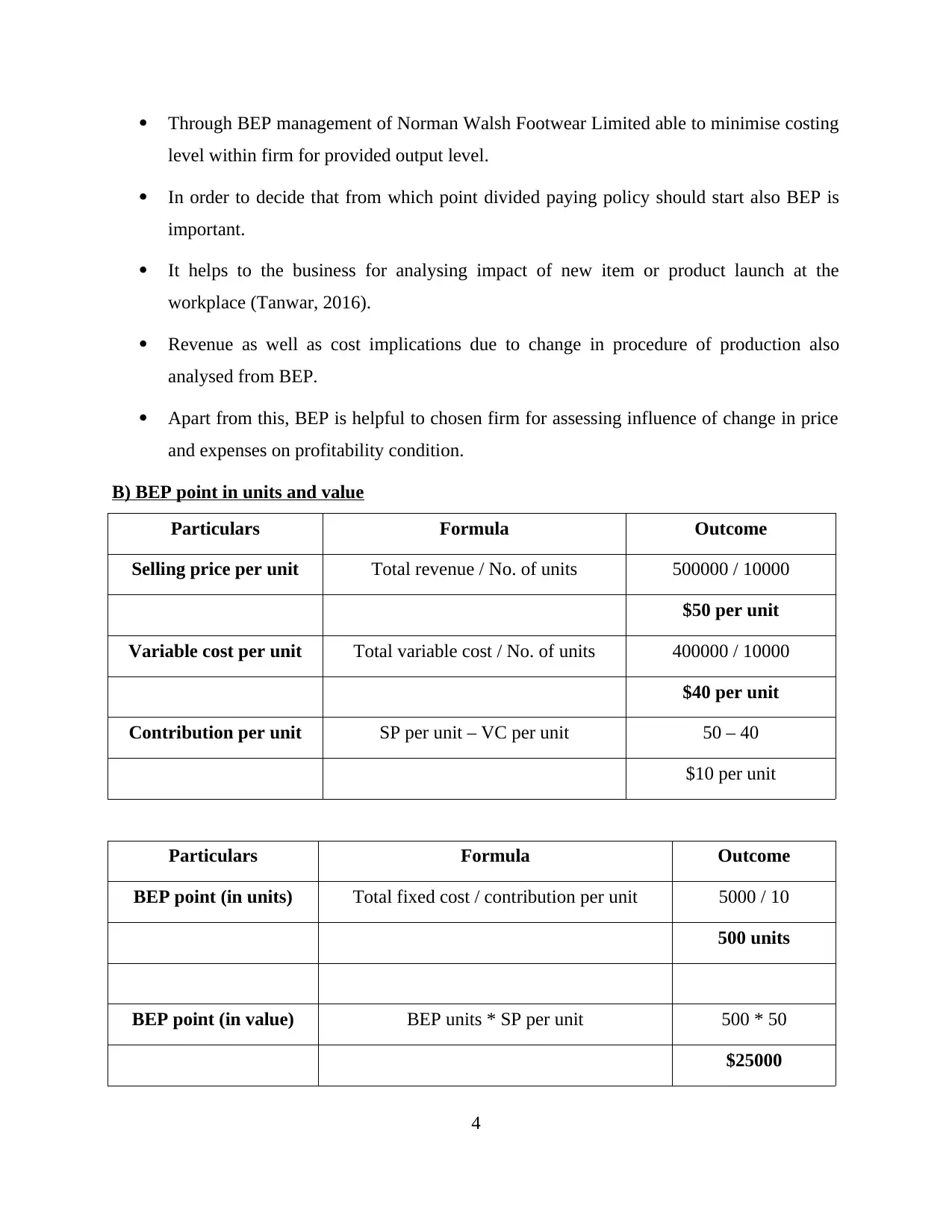
Through BEP management of Norman Walsh Footwear Limited able to minimise costing
level within firm for provided output level.
In order to decide that from which point divided paying policy should start also BEP is
important.
It helps to the business for analysing impact of new item or product launch at the
workplace (Tanwar, 2016).
Revenue as well as cost implications due to change in procedure of production also
analysed from BEP.
Apart from this, BEP is helpful to chosen firm for assessing influence of change in price
and expenses on profitability condition.
B) BEP point in units and value
Particulars Formula Outcome
Selling price per unit Total revenue / No. of units 500000 / 10000
$50 per unit
Variable cost per unit Total variable cost / No. of units 400000 / 10000
$40 per unit
Contribution per unit SP per unit – VC per unit 50 – 40
$10 per unit
Particulars Formula Outcome
BEP point (in units) Total fixed cost / contribution per unit 5000 / 10
500 units
BEP point (in value) BEP units * SP per unit 500 * 50
$25000
4
level within firm for provided output level.
In order to decide that from which point divided paying policy should start also BEP is
important.
It helps to the business for analysing impact of new item or product launch at the
workplace (Tanwar, 2016).
Revenue as well as cost implications due to change in procedure of production also
analysed from BEP.
Apart from this, BEP is helpful to chosen firm for assessing influence of change in price
and expenses on profitability condition.
B) BEP point in units and value
Particulars Formula Outcome
Selling price per unit Total revenue / No. of units 500000 / 10000
$50 per unit
Variable cost per unit Total variable cost / No. of units 400000 / 10000
$40 per unit
Contribution per unit SP per unit – VC per unit 50 – 40
$10 per unit
Particulars Formula Outcome
BEP point (in units) Total fixed cost / contribution per unit 5000 / 10
500 units
BEP point (in value) BEP units * SP per unit 500 * 50
$25000
4
Paraphrase This Document
Need a fresh take? Get an instant paraphrase of this document with our AI Paraphraser
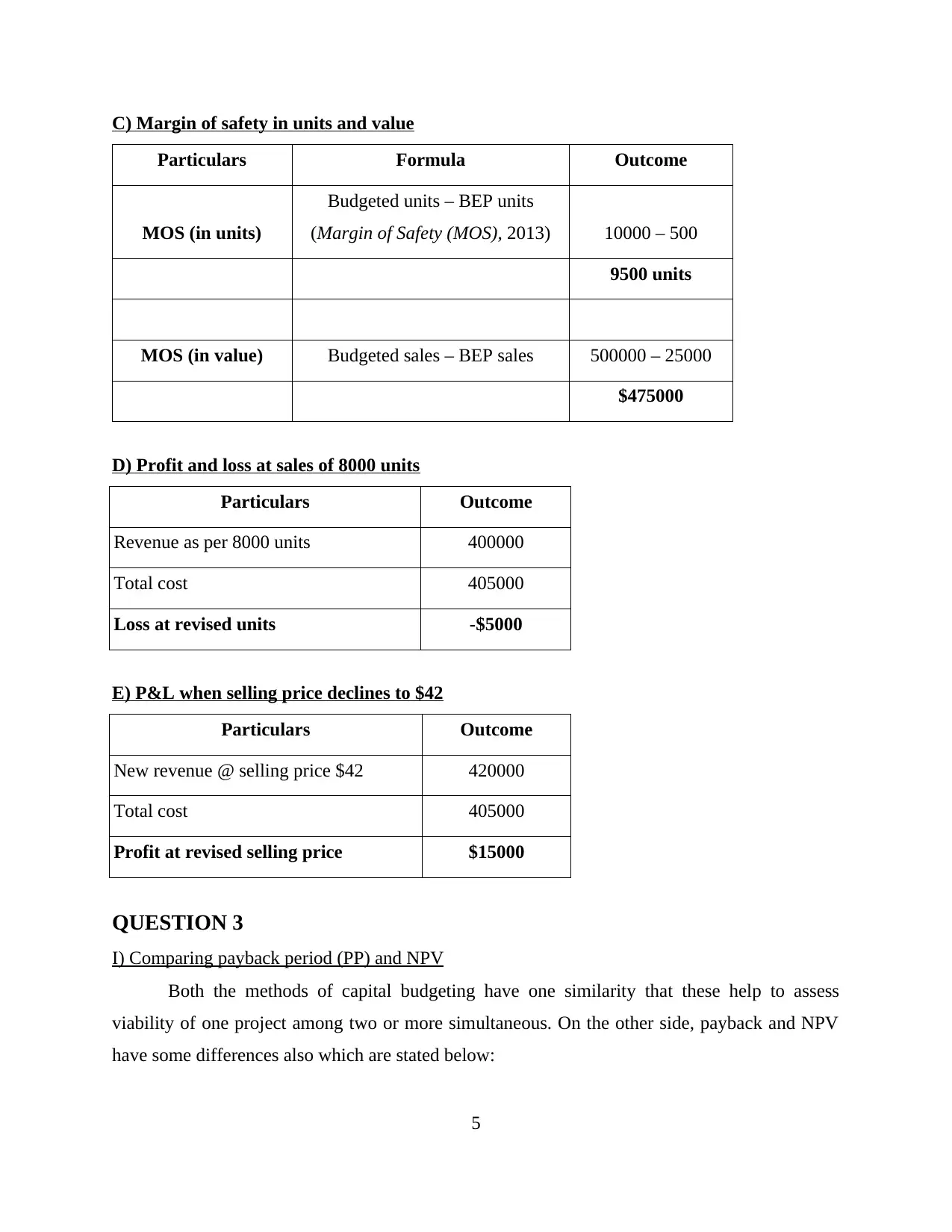
C) Margin of safety in units and value
Particulars Formula Outcome
MOS (in units)
Budgeted units – BEP units
(Margin of Safety (MOS), 2013) 10000 – 500
9500 units
MOS (in value) Budgeted sales – BEP sales 500000 – 25000
$475000
D) Profit and loss at sales of 8000 units
Particulars Outcome
Revenue as per 8000 units 400000
Total cost 405000
Loss at revised units -$5000
E) P&L when selling price declines to $42
Particulars Outcome
New revenue @ selling price $42 420000
Total cost 405000
Profit at revised selling price $15000
QUESTION 3
I) Comparing payback period (PP) and NPV
Both the methods of capital budgeting have one similarity that these help to assess
viability of one project among two or more simultaneous. On the other side, payback and NPV
have some differences also which are stated below:
5
Particulars Formula Outcome
MOS (in units)
Budgeted units – BEP units
(Margin of Safety (MOS), 2013) 10000 – 500
9500 units
MOS (in value) Budgeted sales – BEP sales 500000 – 25000
$475000
D) Profit and loss at sales of 8000 units
Particulars Outcome
Revenue as per 8000 units 400000
Total cost 405000
Loss at revised units -$5000
E) P&L when selling price declines to $42
Particulars Outcome
New revenue @ selling price $42 420000
Total cost 405000
Profit at revised selling price $15000
QUESTION 3
I) Comparing payback period (PP) and NPV
Both the methods of capital budgeting have one similarity that these help to assess
viability of one project among two or more simultaneous. On the other side, payback and NPV
have some differences also which are stated below:
5
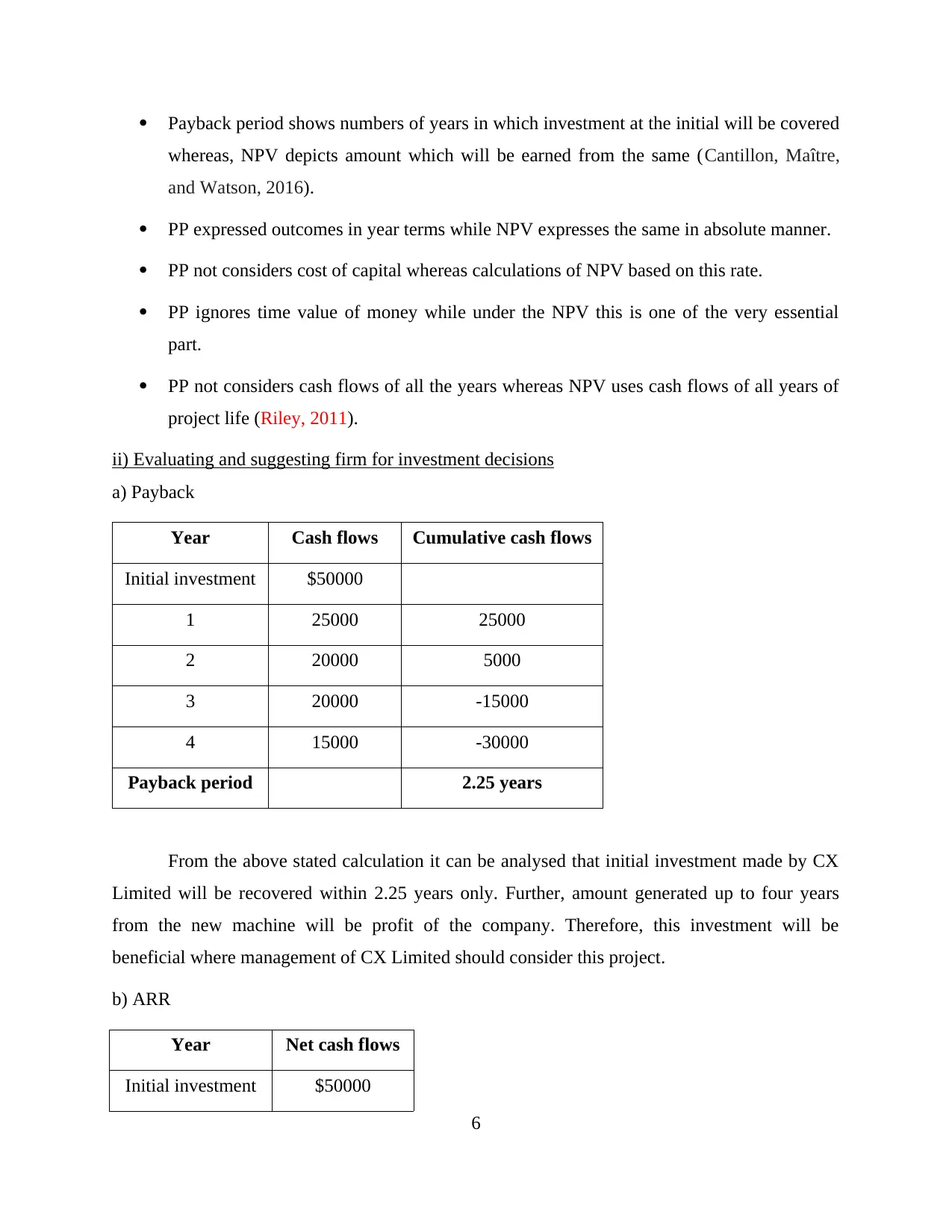
Payback period shows numbers of years in which investment at the initial will be covered
whereas, NPV depicts amount which will be earned from the same (Cantillon, Maître,
and Watson, 2016).
PP expressed outcomes in year terms while NPV expresses the same in absolute manner.
PP not considers cost of capital whereas calculations of NPV based on this rate.
PP ignores time value of money while under the NPV this is one of the very essential
part.
PP not considers cash flows of all the years whereas NPV uses cash flows of all years of
project life (Riley, 2011).
ii) Evaluating and suggesting firm for investment decisions
a) Payback
Year Cash flows Cumulative cash flows
Initial investment $50000
1 25000 25000
2 20000 5000
3 20000 -15000
4 15000 -30000
Payback period 2.25 years
From the above stated calculation it can be analysed that initial investment made by CX
Limited will be recovered within 2.25 years only. Further, amount generated up to four years
from the new machine will be profit of the company. Therefore, this investment will be
beneficial where management of CX Limited should consider this project.
b) ARR
Year Net cash flows
Initial investment $50000
6
whereas, NPV depicts amount which will be earned from the same (Cantillon, Maître,
and Watson, 2016).
PP expressed outcomes in year terms while NPV expresses the same in absolute manner.
PP not considers cost of capital whereas calculations of NPV based on this rate.
PP ignores time value of money while under the NPV this is one of the very essential
part.
PP not considers cash flows of all the years whereas NPV uses cash flows of all years of
project life (Riley, 2011).
ii) Evaluating and suggesting firm for investment decisions
a) Payback
Year Cash flows Cumulative cash flows
Initial investment $50000
1 25000 25000
2 20000 5000
3 20000 -15000
4 15000 -30000
Payback period 2.25 years
From the above stated calculation it can be analysed that initial investment made by CX
Limited will be recovered within 2.25 years only. Further, amount generated up to four years
from the new machine will be profit of the company. Therefore, this investment will be
beneficial where management of CX Limited should consider this project.
b) ARR
Year Net cash flows
Initial investment $50000
6
⊘ This is a preview!⊘
Do you want full access?
Subscribe today to unlock all pages.

Trusted by 1+ million students worldwide
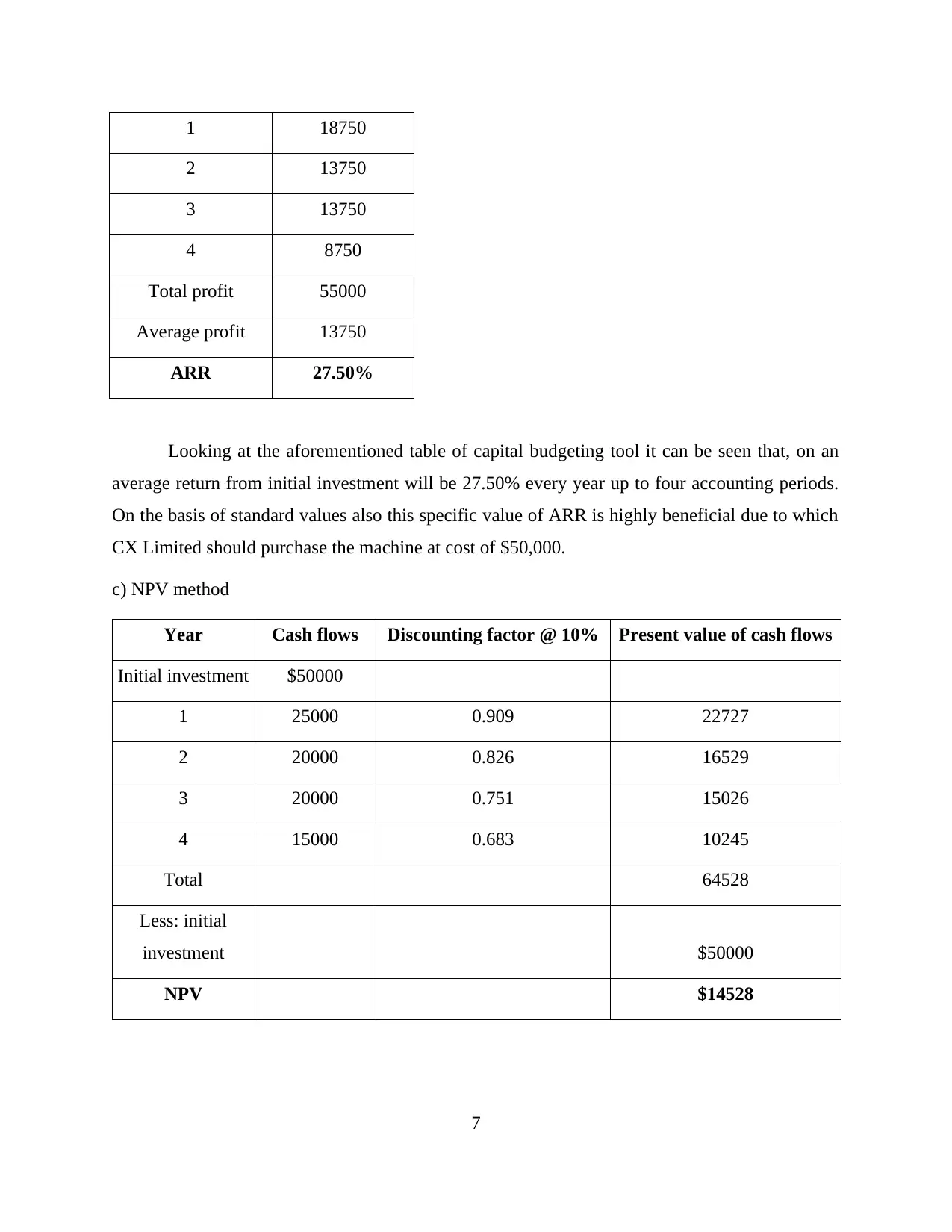
1 18750
2 13750
3 13750
4 8750
Total profit 55000
Average profit 13750
ARR 27.50%
Looking at the aforementioned table of capital budgeting tool it can be seen that, on an
average return from initial investment will be 27.50% every year up to four accounting periods.
On the basis of standard values also this specific value of ARR is highly beneficial due to which
CX Limited should purchase the machine at cost of $50,000.
c) NPV method
Year Cash flows Discounting factor @ 10% Present value of cash flows
Initial investment $50000
1 25000 0.909 22727
2 20000 0.826 16529
3 20000 0.751 15026
4 15000 0.683 10245
Total 64528
Less: initial
investment $50000
NPV $14528
7
2 13750
3 13750
4 8750
Total profit 55000
Average profit 13750
ARR 27.50%
Looking at the aforementioned table of capital budgeting tool it can be seen that, on an
average return from initial investment will be 27.50% every year up to four accounting periods.
On the basis of standard values also this specific value of ARR is highly beneficial due to which
CX Limited should purchase the machine at cost of $50,000.
c) NPV method
Year Cash flows Discounting factor @ 10% Present value of cash flows
Initial investment $50000
1 25000 0.909 22727
2 20000 0.826 16529
3 20000 0.751 15026
4 15000 0.683 10245
Total 64528
Less: initial
investment $50000
NPV $14528
7
Paraphrase This Document
Need a fresh take? Get an instant paraphrase of this document with our AI Paraphraser
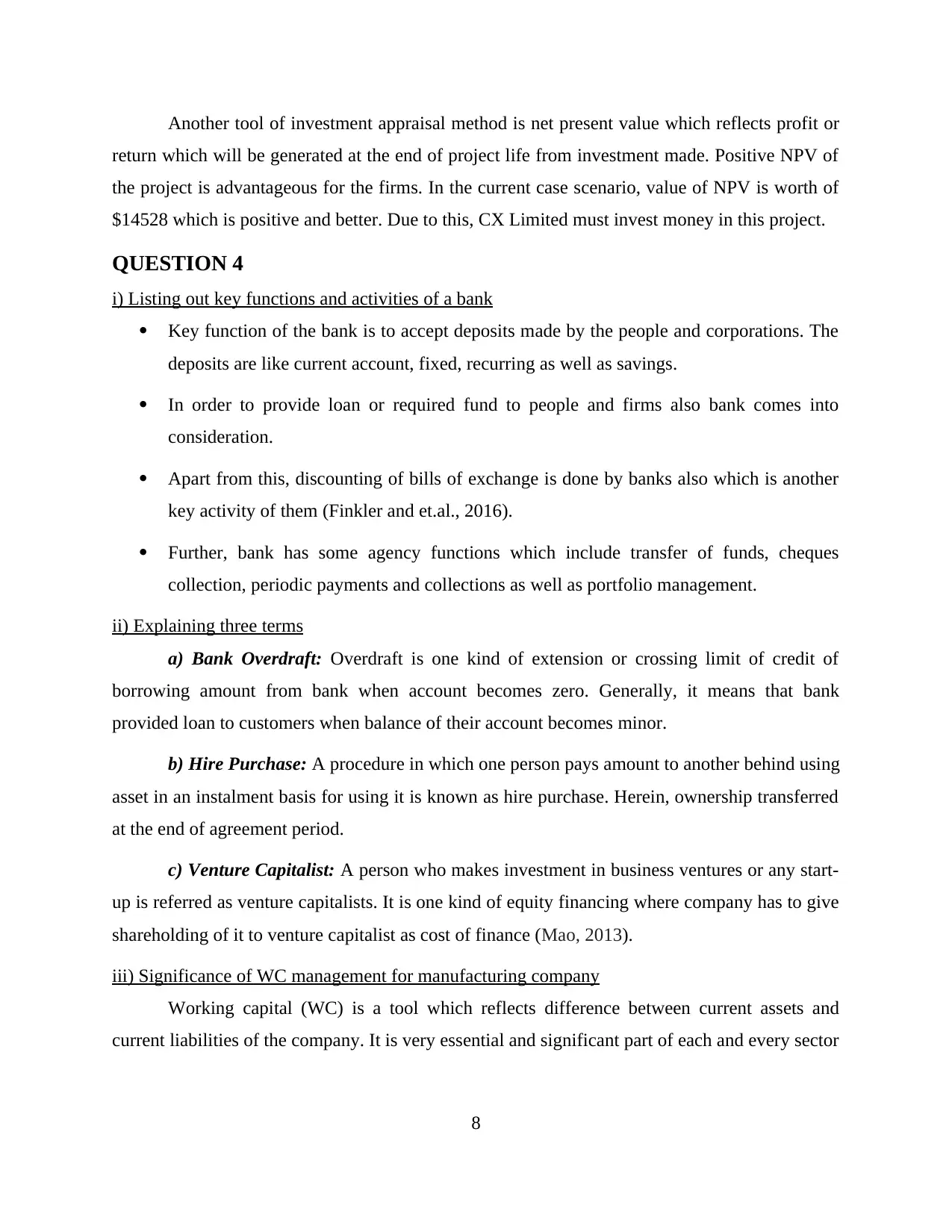
Another tool of investment appraisal method is net present value which reflects profit or
return which will be generated at the end of project life from investment made. Positive NPV of
the project is advantageous for the firms. In the current case scenario, value of NPV is worth of
$14528 which is positive and better. Due to this, CX Limited must invest money in this project.
QUESTION 4
i) Listing out key functions and activities of a bank
Key function of the bank is to accept deposits made by the people and corporations. The
deposits are like current account, fixed, recurring as well as savings.
In order to provide loan or required fund to people and firms also bank comes into
consideration.
Apart from this, discounting of bills of exchange is done by banks also which is another
key activity of them (Finkler and et.al., 2016).
Further, bank has some agency functions which include transfer of funds, cheques
collection, periodic payments and collections as well as portfolio management.
ii) Explaining three terms
a) Bank Overdraft: Overdraft is one kind of extension or crossing limit of credit of
borrowing amount from bank when account becomes zero. Generally, it means that bank
provided loan to customers when balance of their account becomes minor.
b) Hire Purchase: A procedure in which one person pays amount to another behind using
asset in an instalment basis for using it is known as hire purchase. Herein, ownership transferred
at the end of agreement period.
c) Venture Capitalist: A person who makes investment in business ventures or any start-
up is referred as venture capitalists. It is one kind of equity financing where company has to give
shareholding of it to venture capitalist as cost of finance (Mao, 2013).
iii) Significance of WC management for manufacturing company
Working capital (WC) is a tool which reflects difference between current assets and
current liabilities of the company. It is very essential and significant part of each and every sector
8
return which will be generated at the end of project life from investment made. Positive NPV of
the project is advantageous for the firms. In the current case scenario, value of NPV is worth of
$14528 which is positive and better. Due to this, CX Limited must invest money in this project.
QUESTION 4
i) Listing out key functions and activities of a bank
Key function of the bank is to accept deposits made by the people and corporations. The
deposits are like current account, fixed, recurring as well as savings.
In order to provide loan or required fund to people and firms also bank comes into
consideration.
Apart from this, discounting of bills of exchange is done by banks also which is another
key activity of them (Finkler and et.al., 2016).
Further, bank has some agency functions which include transfer of funds, cheques
collection, periodic payments and collections as well as portfolio management.
ii) Explaining three terms
a) Bank Overdraft: Overdraft is one kind of extension or crossing limit of credit of
borrowing amount from bank when account becomes zero. Generally, it means that bank
provided loan to customers when balance of their account becomes minor.
b) Hire Purchase: A procedure in which one person pays amount to another behind using
asset in an instalment basis for using it is known as hire purchase. Herein, ownership transferred
at the end of agreement period.
c) Venture Capitalist: A person who makes investment in business ventures or any start-
up is referred as venture capitalists. It is one kind of equity financing where company has to give
shareholding of it to venture capitalist as cost of finance (Mao, 2013).
iii) Significance of WC management for manufacturing company
Working capital (WC) is a tool which reflects difference between current assets and
current liabilities of the company. It is very essential and significant part of each and every sector
8
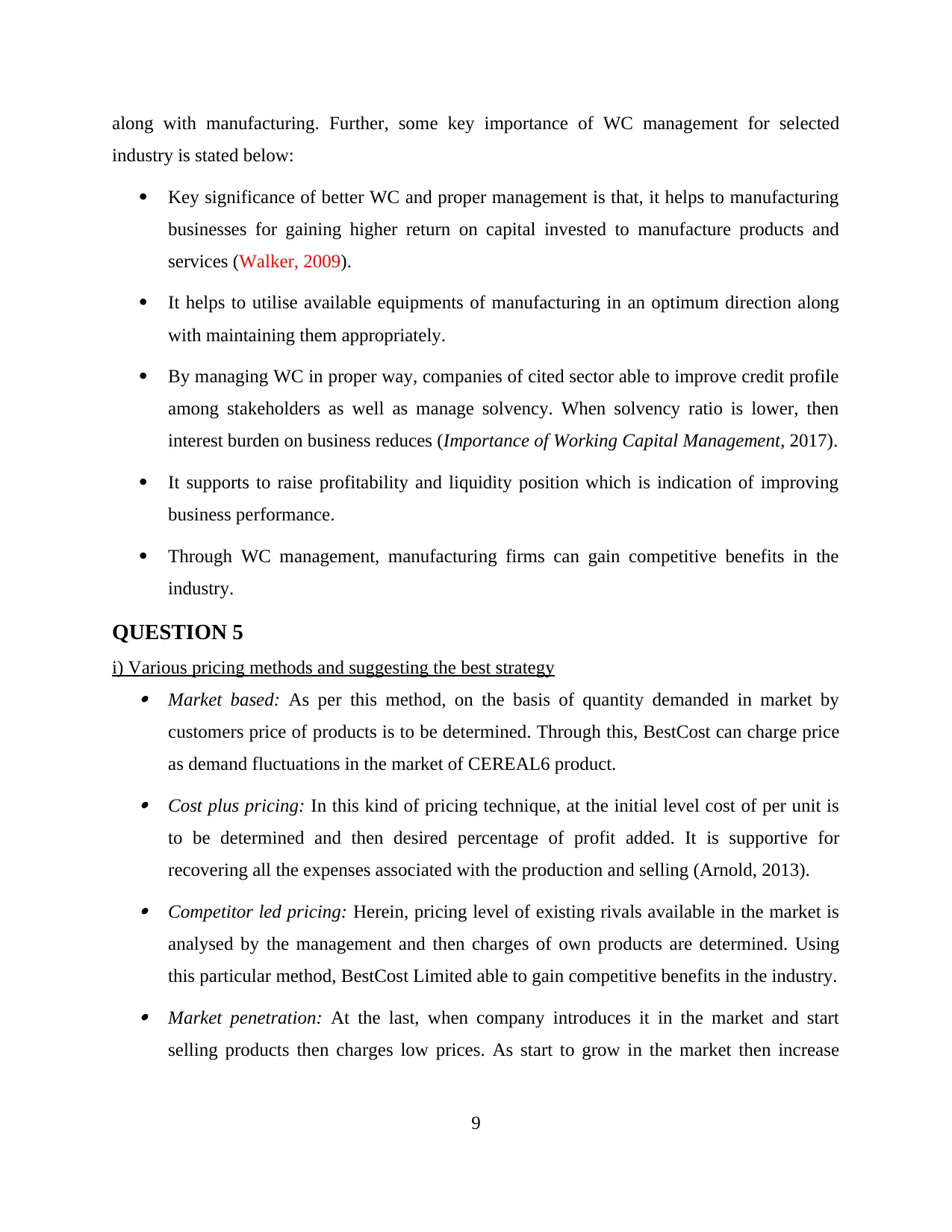
along with manufacturing. Further, some key importance of WC management for selected
industry is stated below:
Key significance of better WC and proper management is that, it helps to manufacturing
businesses for gaining higher return on capital invested to manufacture products and
services (Walker, 2009).
It helps to utilise available equipments of manufacturing in an optimum direction along
with maintaining them appropriately.
By managing WC in proper way, companies of cited sector able to improve credit profile
among stakeholders as well as manage solvency. When solvency ratio is lower, then
interest burden on business reduces (Importance of Working Capital Management, 2017).
It supports to raise profitability and liquidity position which is indication of improving
business performance.
Through WC management, manufacturing firms can gain competitive benefits in the
industry.
QUESTION 5
i) Various pricing methods and suggesting the best strategy Market based: As per this method, on the basis of quantity demanded in market by
customers price of products is to be determined. Through this, BestCost can charge price
as demand fluctuations in the market of CEREAL6 product. Cost plus pricing: In this kind of pricing technique, at the initial level cost of per unit is
to be determined and then desired percentage of profit added. It is supportive for
recovering all the expenses associated with the production and selling (Arnold, 2013). Competitor led pricing: Herein, pricing level of existing rivals available in the market is
analysed by the management and then charges of own products are determined. Using
this particular method, BestCost Limited able to gain competitive benefits in the industry. Market penetration: At the last, when company introduces it in the market and start
selling products then charges low prices. As start to grow in the market then increase
9
industry is stated below:
Key significance of better WC and proper management is that, it helps to manufacturing
businesses for gaining higher return on capital invested to manufacture products and
services (Walker, 2009).
It helps to utilise available equipments of manufacturing in an optimum direction along
with maintaining them appropriately.
By managing WC in proper way, companies of cited sector able to improve credit profile
among stakeholders as well as manage solvency. When solvency ratio is lower, then
interest burden on business reduces (Importance of Working Capital Management, 2017).
It supports to raise profitability and liquidity position which is indication of improving
business performance.
Through WC management, manufacturing firms can gain competitive benefits in the
industry.
QUESTION 5
i) Various pricing methods and suggesting the best strategy Market based: As per this method, on the basis of quantity demanded in market by
customers price of products is to be determined. Through this, BestCost can charge price
as demand fluctuations in the market of CEREAL6 product. Cost plus pricing: In this kind of pricing technique, at the initial level cost of per unit is
to be determined and then desired percentage of profit added. It is supportive for
recovering all the expenses associated with the production and selling (Arnold, 2013). Competitor led pricing: Herein, pricing level of existing rivals available in the market is
analysed by the management and then charges of own products are determined. Using
this particular method, BestCost Limited able to gain competitive benefits in the industry. Market penetration: At the last, when company introduces it in the market and start
selling products then charges low prices. As start to grow in the market then increase
9
⊘ This is a preview!⊘
Do you want full access?
Subscribe today to unlock all pages.

Trusted by 1+ million students worldwide
1 out of 16
Related Documents
Your All-in-One AI-Powered Toolkit for Academic Success.
+13062052269
info@desklib.com
Available 24*7 on WhatsApp / Email
![[object Object]](/_next/static/media/star-bottom.7253800d.svg)
Unlock your academic potential
Copyright © 2020–2025 A2Z Services. All Rights Reserved. Developed and managed by ZUCOL.




